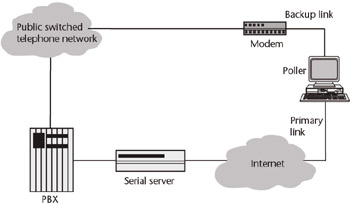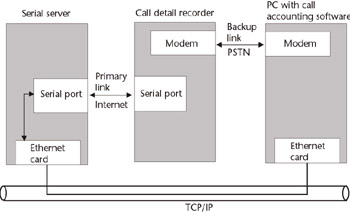7.6 Call Detail Reporting
|
| < Day Day Up > |
|
Call accounting systems are used by businesses and other organizations to capture detailed data about telephone calls. The accumulated data is stored on a PC or other collection device and then processed into a variety of cost and usage reports. Such systems are offered in the form of standalone products, or they may be one of several modules within a suite of management applications that include one or more of the following functions:
-
Call center management;
-
Move, add, and change administration;
-
Cable management;
-
Inventory management;
-
Invoice management;
-
Lease management;
-
Trouble reporting and tracking;
-
Work order management;
-
Traffic analysis;
-
Network design and optimization.
7.6.1 Benefits
Call accounting systems represent a powerful management tool that can be used to monitor complete telephone system usage by every employee—including phone, fax, modem, and dial-up Internet connection time. Such systems provide organizations with the following benefits:
-
Reduce toll fraud: On-line, real-time fraud detection can notify telecom managers as it is occurring so it can be stopped before it gets out of hand.
-
Reduce unauthorized use: If employees know that telephone usage is monitored, including incoming calls and local calls, the number of personal calls decreases.
-
Charge allocation: Call charges can be billed back to the actual extensions, projects, or departments that incurred the cost.
-
Cost allocation: Administrative charges can be allocated to departments to help pay for the telephone system and its management.
-
Tenant billing: If the organization leases office space to other companies or individuals, they can be billed directly for their phone usage.
-
Increase productivity: Since telephone usage can be monitored, unnecessary calls are decreased, which increases productivity; if the job description requires phone contact, being able to monitor the number of calls is an indicator of productivity.
7.6.2 Operation
Call records are collected from one or more locations via a polling process, which is usually done by a PC. Multiple sites can feed their data simultaneously into a single recording PC via a dial-up or dedicated line. During the polling session, CRC is used for error correction. Compression can be added to minimize collection time and save on long-distance call charges. User-defined filters can be applied to exclude certain types of call records from being captured. Once the relevant data is collected, it can be processed into the appropriate report formats.
At each location, there is typically a solid-state recording unit that attaches to the PBX. These devices are available with various memory capacities that range from 256 Kbps to 8 Mbps. They include a battery backup that preserves data integrity for 30 to 60 days in case of a local power failure. The devices also have a graphical interface that is used by management. Through this interface, system settings can be set, including the system and polling parameters, as well as alarm and callback schedules.
Several polling methods are available. Polling can be triggered when the station message detail recording (SMDR) device reaches 80% full to ensure that buffers are not overwritten before the call data is retrieved. Polling sessions can occur on a scheduled basis for each location. Polling can also be initiated manually. The telecom manager determines the number of automatic retries (if the line is busy) and restarts (if transmission is aborted) during a polling session.
Some polling applications can collect call detail records over TCP/IP networks, including the Internet, at a much lower cost than traditional long-distance services (see Figure 7.7). A PC acts as a polling device and works in conjunction with a serial server, which acts as a protocol converter that can translate RS-232 serial data into IP packets. Commands can be automatically sent from a PC over the network through a serial server to the solid state recorder’s buffer box to begin polling the call detail records. The records move via the solid state recorder’s serial port into the serial server, where data is packetized and sent across the TCP/IP network to the PC where the call accounting software resides (see Figure 7.8). There, the call detail records are processed into various reports.

Figure 7.7: A typical configuration of a call accounting system. A backup modem is used for polling over the PSTN if the TCP/IP network is unavailable.
7.6.3 Call Detail Records
Call accounting systems produce reports from SMDR devices, which capture call detail records generated by PBX, Centrex, hybrid, or key telephone systems, or from tip-and-ring line scanners. Most call accounting systems compute costs for each outgoing call, whether local or long distance. Call detail records usually contain the following basic fields:
-
Number called;
-
City called;
-
Extension number;
-
Authorization code (if applicable);
-
Date of call;
-
Time of call;

Figure 7.8: Detailed view of how the PC poller is configured. -
Type of call (local or long distance);
-
Duration of call;
-
Cost of call.
The information from call reports can be printed in detail or summarized by such categories as individual station, department, or project. Other summary categories might also include the most frequently dialed numbers, longest-duration calls, or highest-cost calls.
Standard call accounting reports can be used to locate toll fraud by identifying short, frequent calls; long-duration calls; unusual calling patterns; and unusual activity on 800 and 900 numbers. In addition, the reports can be used to identify calls made after hours, on weekends, or holidays. Some vendors offer special toll-fraud detection packages. These programs alert managers to changes in calling patterns or breached overflow thresholds. Several types of alarms indicating suspicious activity can be generated and sent to a printer, a local PC, remote PC, or a pager.
7.6.4 Call Costing
A key feature of call accounting systems is call costing. For each call record, the cost per call can be figured in a variety of ways to suit various organizational needs, including the following:
-
Actual route cost;
-
Comparison route cost;
-
User-defined least-cost route;
-
What-if recosting for comparison;
-
Equipment charge assignment;
-
User-definable pricing by route group;
-
Tariff table pricing;
-
Usage sensitive pricing;
-
Flat rate with percentage surcharge;
-
Minimum charge;
-
Evening and night discounts;
-
Operator-assisted charge.
The ability to price calls according to various parameters gives the organization flexibility in allocating costs and meeting budgetary targets. A related feature of call accounting systems is cost allocation, which is used to distribute call costs to the appropriate internal departments, projects or clients, workgroups or subsidiaries, or external customers or individuals. With this feature, costs can be applied to calls that also include the cost for equipment, trunks, lines, maintenance, or other administrative charges. Some systems can also depreciate equipment according to organizational depreciation schedules. Most cost-allocation applications also provide an interface to the organization’s general ledger.
7.6.5 Outsourcing
An alternative to in-house call detail record collection and processing is the third-party service bureau. The service bureau collects call records from a PC or other type of recording device at the customer’s premises via a dial-up connection or dedicated line—depending on the call record volume—on a daily, weekly, or monthly basis. The call detail records are processed into reports for the customer. The client may choose from among a set of standard reports or have the data processed into custom reports.
Some third-party processing firms offer carrier billing verification services. Audits verify that carrier invoices accurately reflect charges for telephone services (voice and data) and equipment actually contracted for and used, assuring that appropriate rates, taxes, and surcharges have been properly applied. Refund requests are prepared and submitted to ensure that customers receive the appropriate reimbursement for incorrect prior bills, as well as ensure that future bills are accurate. Refunds of historical overcharges have produced ongoing savings to customers generally ranging from 5% to as much as 15% of basic monthly service charges.
7.6.6 Web-Based Reporting
An alternative to call detail reporting and outsourced bill processing is Web-based reporting, which is available from the carrier. MCI WorldCom, for example, lets business customers access their account information from its Web site using any standard Web browser that supports secure sockets layer (SSL) encryption. All the tools are available to customers free of charge. The tools include electronic billing and reporting, broadband reporting, price reporting, traffic reporting and traffic monitoring.
Electronic billing and reporting lets users easily view invoices, run reports, and pay their voice and data bills monthly. After accessing the Web page, users can transfer funds from their banks to a preapproved MCI WorldCom financial institution to pay their bills. Users can also print bills and mail the invoices with payment.
The broadband reporting feature lets ATM and frame-relay users monitor their data connections and generate monthly or daily reports on usage. The tool is also useful in determining when a link may be reaching capacity.
The price reporting tool allows users to receive rated-call detail records on a daily or monthly basis so they can determine usage and costs. The information allows administrators to manage voice services more efficiently.
The traffic reporting and traffic monitoring tools are specifically designed for MCI WorldCom’s toll-free users. These tools let users gather information such as peak calling times and overall network utilization for departmental charge-backs.
|
| < Day Day Up > |
|
EAN: 2147483647
Pages: 184